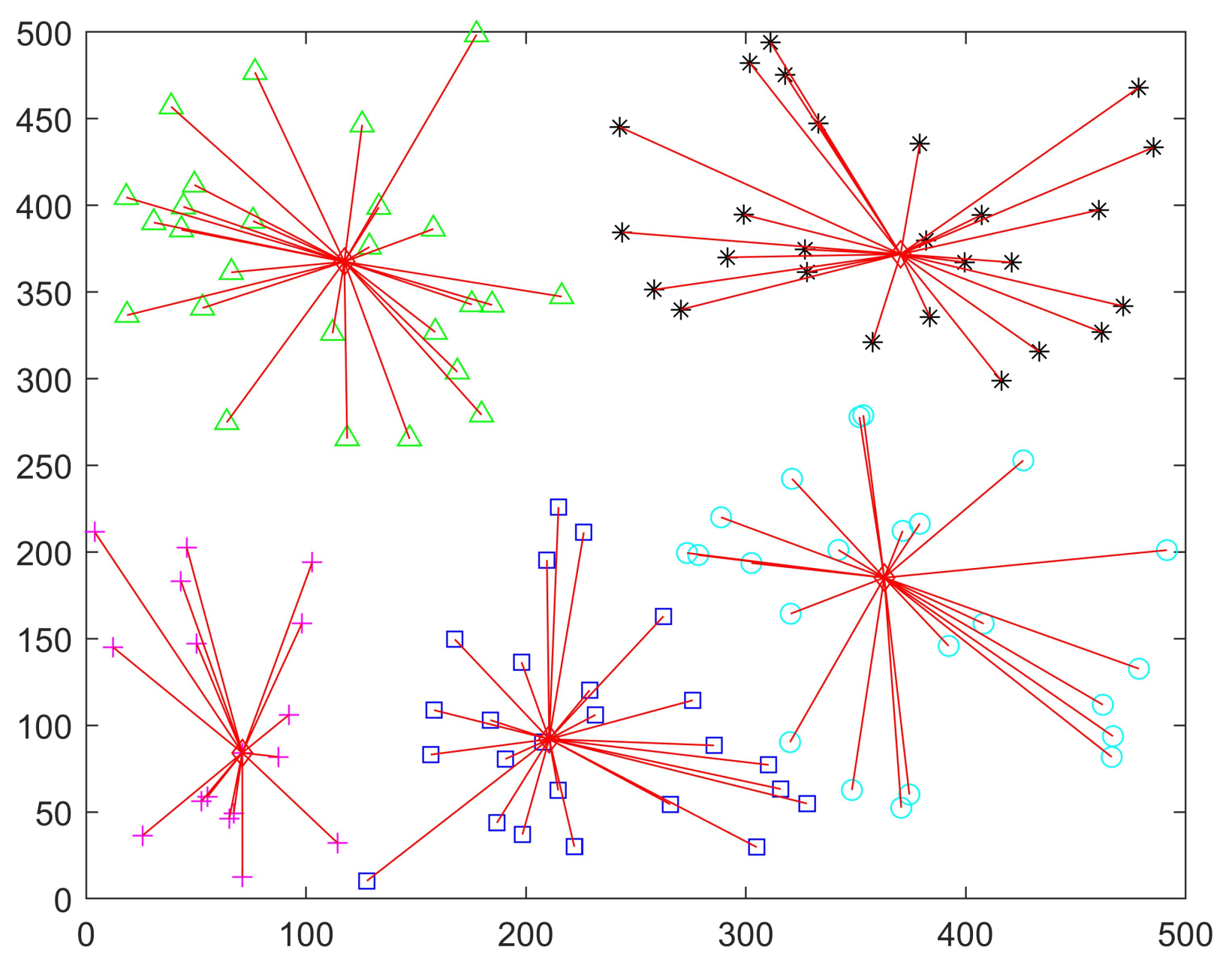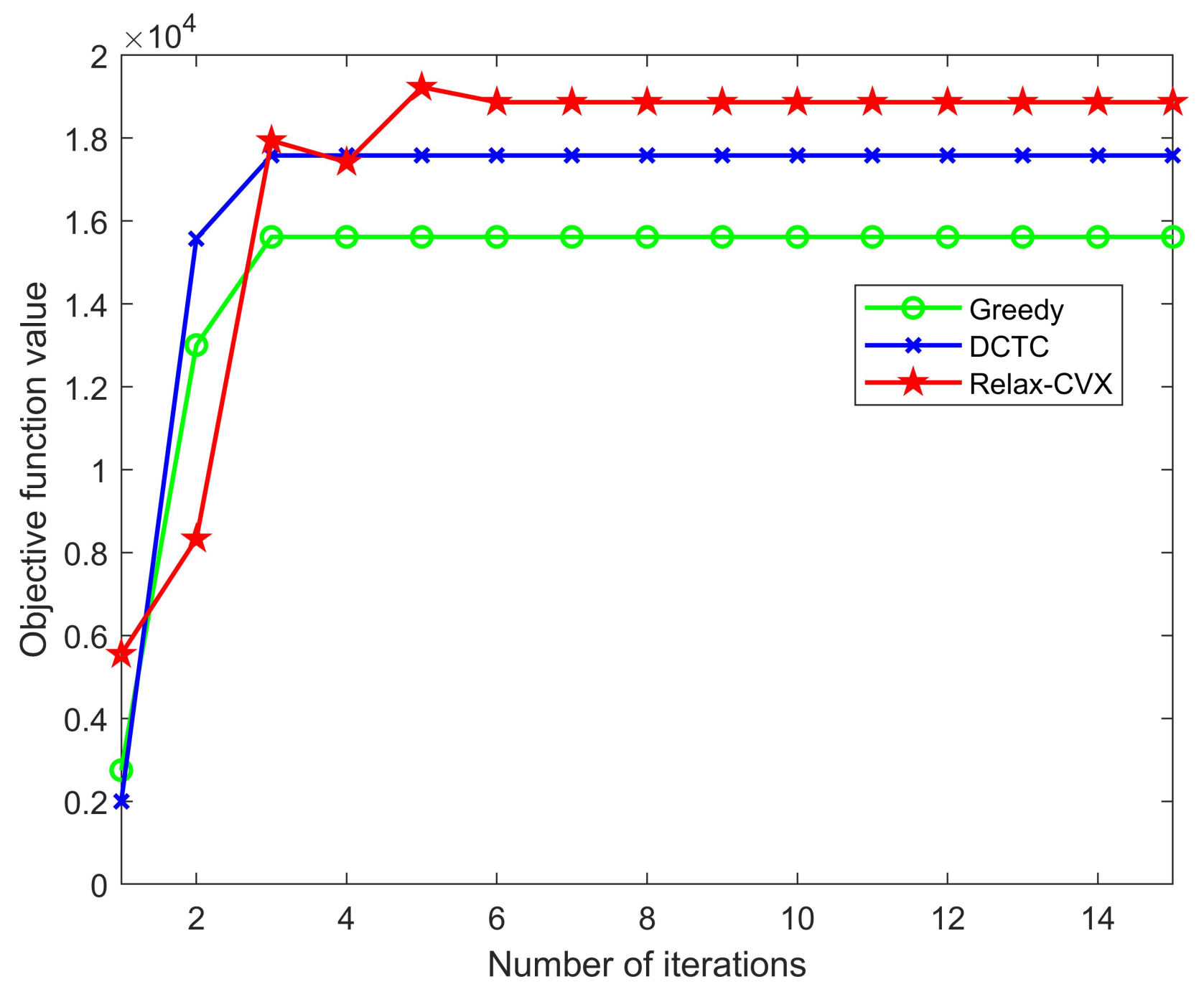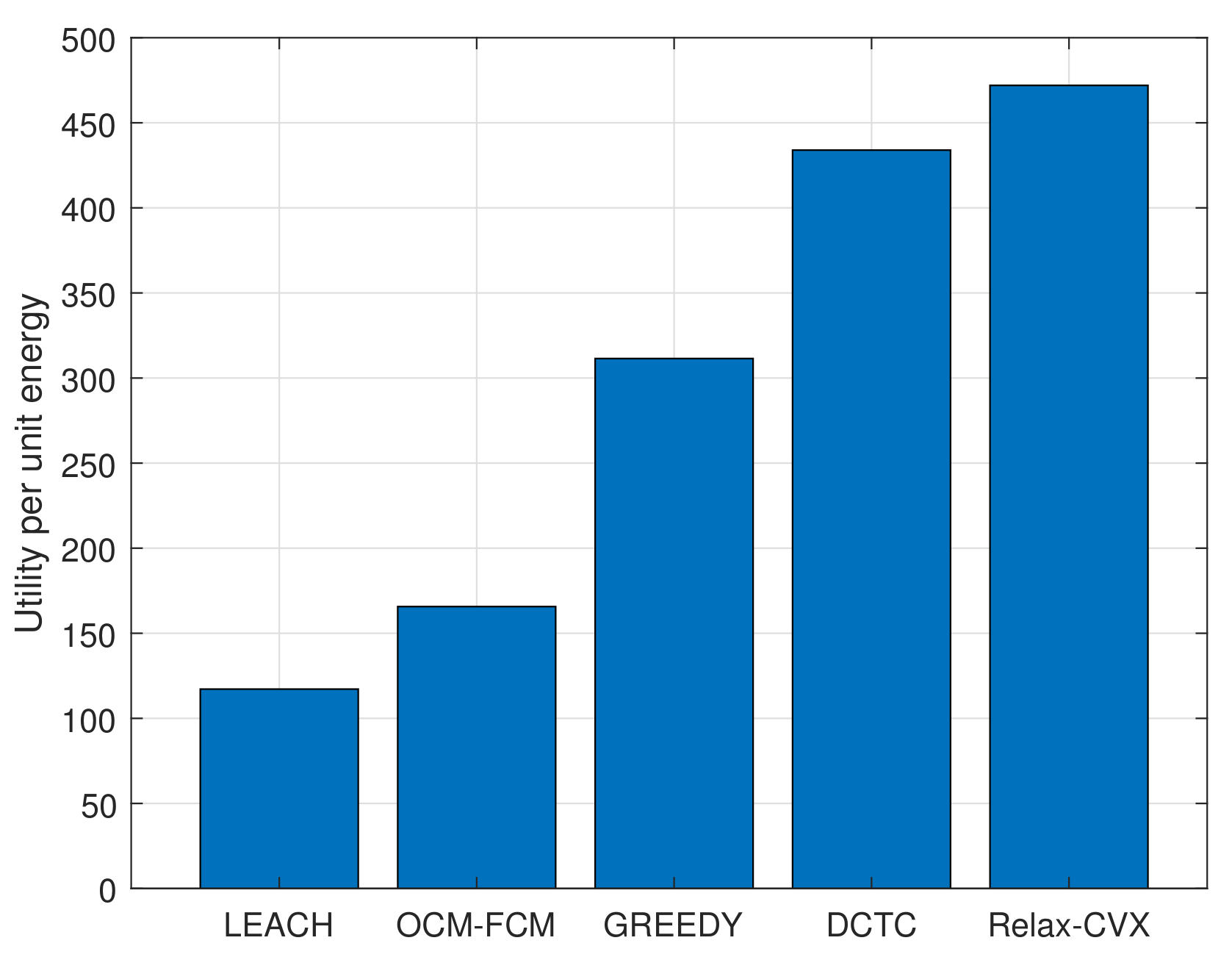Optimal Sensor Association and Data Collection in Power Materials Warehouse Based on Internet of Things
Abstract
:1. Introduction
- This paper integrates the data collection satisfaction and sensor association for wireless sensing networks in a power materials warehouse of smart grid and constructs a joint optimization problem. Finally, a high-quality suboptimal solution was found by the BCD algorithm;
- On the basis of finding the optimal amount of collection data, sensor association is reduced to a knapsack problem, and the ACO-based sensor association scheme is proposed to solve the problem. The practical simulations show that the gap of the suboptimal solution obtained by this algorithm is relatively small.
- The optimal sensor association and cluster head selection are also obtained to achieve an optimal topology control strategy for the WSNs.
2. Literature Review
3. System Model
Energy Consumption Model
4. Topology Control and Data Collection Satisfaction
4.1. Problem Formulation
4.2. Problem Solution
4.2.1. Data Collection Optimization
4.2.2. Sensor Association Optimization
4.2.3. ACO-Based Sensor Association Scheme
| Algorithm 1 ACO-Based Sensor Association Scheme (ACOSA) |
|
4.2.4. Cluster Head Selection
4.3. Overall Algorithm Design
| Algorithm 2 Data Collection and Topology Control based on ACO (DCTC) |
|
5. Experiment Simulation
6. Conclusions
Author Contributions
Funding
Institutional Review Board Statement
Informed Consent Statement
Data Availability Statement
Conflicts of Interest
References
- Yang, L.; Zheng, Y.; Xu, Y.; Bai, Y. Research on Location Assignment Model of Intelligent Warehouse with RFID and Improved Particle Swarm Optimization Algorithm. In Proceedings of the 2017 International Conference on Computer Systems, Electronics and Control (ICCSEC), Dalian, China, 25–27 December 2017; pp. 1262–1266. [Google Scholar]
- Yang, J. Design and Study of Intelligent Warehousing System Based on RFID Technology. In Proceedings of the 2019 International Conference on Intelligent Transportation, Big Data Smart City (ICITBS), Changsha, China, 12–13 January 2019; pp. 393–396. [Google Scholar] [CrossRef]
- Lu, X.; Lai, J. Communication Constraints for Distributed Secondary Control of Heterogenous Microgrids: A Survey. IEEE Trans. Ind. Appl. 2021. [Google Scholar] [CrossRef]
- Ongaro, F.; Saggini, S.; Mattavelli, P. Li-Ion Battery-Supercapacitor Hybrid Storage System for a Long Lifetime, Photovoltaic-Based Wireless Sensor Network. IEEE Trans. Power Electron. 2012, 27, 3944–3952. [Google Scholar] [CrossRef]
- Xiong, W.; Hu, X.; Jiang, T. Measurement and Characterization of Link Quality for IEEE 802.15.4-Compliant Wireless Sensor Networks in Vehicular Communications. IEEE Trans. Ind. Inform. 2016, 12, 1702–1713. [Google Scholar] [CrossRef]
- Jose, J.; Samhitha, B.K.; Maheswari, M.; Selvi, M.; Mana, S.C. IoT based Smart Warehouse and Crop Monitoring System. In Proceedings of the 2021 5th International Conference on Trends in Electronics and Informatics (ICOEI), Tirunelveli, India, 3–5 June 2021; pp. 473–476. [Google Scholar]
- Makwana, N.D.; Kumar, A. Virtual Cluster Head-set based Avalanche Predication in Himalayan region. In Proceedings of the 2014 IEEE International Conference on Advanced Communications, Control and Computing Technologies, Ramanathapuram, India, 8–10 May 2014; pp. 683–687. [Google Scholar]
- Zhong, L.; Ge, M.; Zhang, S.; Liu, Y. Rate Aware Fuzzy Clustering and Stable Sensor Association for Load Balancing in WSNs. IEEE Internet Things J. 2021. [Google Scholar] [CrossRef]
- Abderrahmane, E.A.; Hajraoui, A. Organized Selection Cluster Head on Fuzzy Low-Energy Adaptive Clustering Hierarchy Protocol in Three-Dimensional Wireless Sensor Networks. Int. J. Sens. Wirel. Commun. Control 2021, 11, 362–371. [Google Scholar]
- Younis, O.; Fahmy, S. HEED: A hybrid, energy-efficient, distributed clustering approach for ad hoc sensor networks. IEEE Trans. Mob. Comput. 2004, 3, 366–379. [Google Scholar] [CrossRef] [Green Version]
- Ye, M.; Li, C.; Chen, G.; Wu, J. EECS: An energy efficient clustering scheme in wireless sensor networks. In Proceedings of the PCCC 2005 24th IEEE International Performance, Computing, and Communications Conference, Phoenix, AZ, USA, 7–9 April 2005; pp. 535–540. [Google Scholar]
- Lee, J.S.; Teng, C.L. An Enhanced Hierarchical Clustering Approach for Mobile Sensor Networks Using Fuzzy Inference Systems. IEEE Internet Things J. 2017, 4, 1095–1103. [Google Scholar] [CrossRef]
- Zamini, M.S.; Zare, L. A reward based method to wireless sensor network clustering. In Proceedings of the 2009 International Conference on Application of Information and Communication Technologies, Azerbaijan, Baku, 14–16 October 2009; pp. 1–7. [Google Scholar]
- Lee, K.; Lee, J.; Lee, H.; Shin, Y. A Density and Distance based Cluster Head Selection algorithm in Sensor Networks. In Proceedings of the 2010 The 12th International Conference on Advanced Communication Technology (ICACT), Phoenix Park, Korea, 7–10 February 2010; Volume 1, pp. 162–165. [Google Scholar]
- Kang, S.H.; Nguyen, T. Distance Based Thresholds for Cluster Head Selection in Wireless Sensor Networks. IEEE Commun. Lett. 2012, 16, 1396–1399. [Google Scholar] [CrossRef]
- Ni, Q.; Pan, Q.; Du, H.; Cao, C.; Zhai, Y. A Novel Cluster Head Selection Algorithm Based on Fuzzy Clustering and Particle Swarm Optimization. IEEE/ACM Trans. Comput. Biol. Bioinform. 2017, 14, 76–84. [Google Scholar] [CrossRef] [PubMed]
- Umbreen, S.; Shehzad, D.; Shafi, N.; Khan, B.; Habib, U. An Energy-Efficient Mobility-Based Cluster Head Selection for Lifetime Enhancement of Wireless Sensor Networks. IEEE Access 2020, 8, 207779–207793. [Google Scholar] [CrossRef]
- Heinzelman, W.; Chandrakasan, A.; Balakrishnan, H. An application-specific protocol architecture for wireless microsensor networks. IEEE Trans. Wirel. Commun. 2002, 1, 660–670. [Google Scholar] [CrossRef] [Green Version]
- Zhao, J.; Erdogan, A. A Novel Self-Organizing Hybrid Network Protocol for Wireless Sensor Networks. In Proceedings of the First NASA/ESA Conference on Adaptive Hardware and Systems (AHS’06), Istanbul, Turkey, 15–18 June 2006; pp. 412–419. [Google Scholar]
- Gengsheng, Z.; Xiaohua, L.; Xingming, H.; Weidong, Z. The research of clustering protocol based on chain routing in WSNs. In Proceedings of the 2009 Asia-Pacific Conference on Computational Intelligence and Industrial Applications (PACIIA), Wuhan, China, 28–29 November 2009; Volume 1, pp. 292–295. [Google Scholar]
- Allirani, A.; Suganthi, M. An Energy Sorting Protocol with Reduced Energy and Latency for Wireless Sensor Networks. In Proceedings of the 2009 IEEE International Advance Computing Conference, Patiala, India, 6–7 March 2009; pp. 1562–1568. [Google Scholar]
- Han, Y.; Li, G.; Xu, R.; Su, J.; Li, J.; Wen, G. Clustering the Wireless Sensor Networks: A Meta-Heuristic Approach. IEEE Access 2020, 8, 214551–214564. [Google Scholar] [CrossRef]
- Lai, J.; Lu, X.; Dong, Z.; Cheng, S. Resilient Distributed Multiagent Control for AC Microgrid Networks Subject to Disturbances. IEEE Trans. Syst. Man Cybern. Syst. 2021. [Google Scholar] [CrossRef]
- Chubing, Z.; Ru-jing, H. Optimal Portfolios for DC Pension under the Quadratic Utility Function. In Proceedings of the 2011 International Conference of Information Technology, Computer Engineering and Management Sciences, Nanjing, China, 24–25 September 2011; Volume 1, pp. 297–300. [Google Scholar]
- Chang, H.; Chang, K. An investment and consumption problem for quadratic utility function in an incomplete market. In Proceedings of the 2012 24th Chinese Control and Decision Conference (CCDC), Taiyuan, China, 23–25 May 2012; pp. 2039–2042. [Google Scholar]
- Heinzelman, W.; Chandrakasan, A.; Balakrishnan, H. Energy-efficient communication protocol for wireless microsensor networks. In Proceedings of the 33rd Annual Hawaii International Conference on System Sciences, Maui, HI, USA, 7 January 2000; Volume 2, p. 10. [Google Scholar]
- Ren, J.; Zhang, Y.; Zhang, N.; Zhang, D.; Shen, X. Dynamic Channel Access to Improve Energy Efficiency in Cognitive Radio Sensor Networks. IEEE Trans. Wirel. Commun. 2016, 15, 3143–3156. [Google Scholar] [CrossRef]
- Hong, M.; Razaviyayn, M.; Luo, Z.Q.; Pang, J.S. A Unified Algorithmic Framework for Block-Structured Optimization Involving Big Data: With applications in machine learning and signal processing. IEEE Signal Process. Mag. 2016, 33, 57–77. [Google Scholar] [CrossRef] [Green Version]
- Chen, J.; Wu, H.; Yang, P.; Lyu, F.; Shen, X. Cooperative Edge Caching With Location-Based and Popular Contents for Vehicular Networks. IEEE Trans. Veh. Technol. 2020, 69, 10291–10305. [Google Scholar] [CrossRef]
- Su, S.; Zhao, S. An optimal clustering mechanism based on Fuzzy-C means for wireless sensor networks. Sustain. Comput. Inform. Syst. 2017, 18, 127–134. [Google Scholar] [CrossRef]






| Variable | Parameter |
|---|---|
| Energy consumed per unit of data acquisition | |
| a | Risk aversion coefficient of utility function |
| The amount of data collected | |
| The efficiency of the power amplifier | |
| Transmission power | |
| Circuit power consumption of data transmission | |
| r | Data transmission rate |
| Circuit power for receiving the data | |
| Association decision | |
| Maximum number of CMs that the CH can access | |
| The energy consumption per bit of data fusion |
| Variable | Parameter | Value |
|---|---|---|
| S | Distribution area | |
| Deployment density of WSN nodes | 250 | |
| Maximum access number of CHs | 30 | |
| Satisfaction coefficient | ||
| Trade-off parameter | 100 | |
| Energy cost for data acquisition | ||
| Data transmission power | 20 mW | |
| Power amplifier efficiency | 0.9 | |
| Circuit power | 5 mW | |
| Energy consumption for data receiving | 5 nJ/bit | |
| Energy cost for data aggregation | 0.5 nJ/bit | |
| Maximum data collection amount | 1000 bit |
Publisher’s Note: MDPI stays neutral with regard to jurisdictional claims in published maps and institutional affiliations. |
© 2021 by the authors. Licensee MDPI, Basel, Switzerland. This article is an open access article distributed under the terms and conditions of the Creative Commons Attribution (CC BY) license (https://creativecommons.org/licenses/by/4.0/).
Share and Cite
He, F.; Xu, J.; Zhong, J.; Chen, G.; Peng, S. Optimal Sensor Association and Data Collection in Power Materials Warehouse Based on Internet of Things. Energies 2021, 14, 7449. https://doi.org/10.3390/en14217449
He F, Xu J, Zhong J, Chen G, Peng S. Optimal Sensor Association and Data Collection in Power Materials Warehouse Based on Internet of Things. Energies. 2021; 14(21):7449. https://doi.org/10.3390/en14217449
Chicago/Turabian StyleHe, Fangqiuzi, Junfeng Xu, Jinglin Zhong, Guang Chen, and Shixin Peng. 2021. "Optimal Sensor Association and Data Collection in Power Materials Warehouse Based on Internet of Things" Energies 14, no. 21: 7449. https://doi.org/10.3390/en14217449
APA StyleHe, F., Xu, J., Zhong, J., Chen, G., & Peng, S. (2021). Optimal Sensor Association and Data Collection in Power Materials Warehouse Based on Internet of Things. Energies, 14(21), 7449. https://doi.org/10.3390/en14217449






